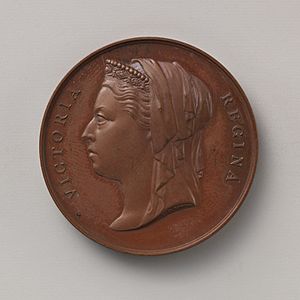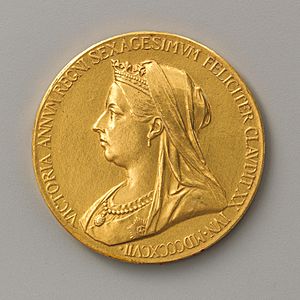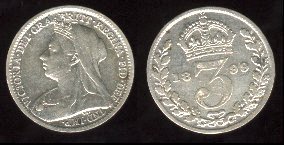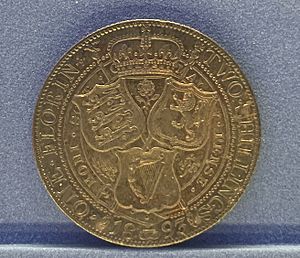Old Head coinage facts for kids
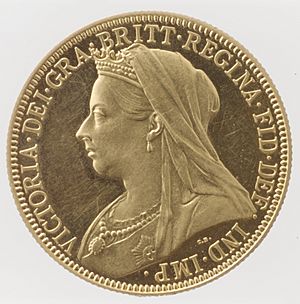
The Old Head coinage or Veiled Head coinage refers to British coins made between 1893 and 1901. These coins showed an older Queen Victoria on the front, designed by Thomas Brock. She wore a special crown (diadem) partly hidden by a widow's veil. These new coins replaced the Jubilee coinage from 1887, which many people didn't like. The old coins had a portrait of the Queen that was criticised, and most of them didn't even say their value on the back.
Some of the new "Old Head" coins kept their old designs on the back. For example, the sovereign and half sovereign continued to use the famous Benedetto Pistrucci design of Saint George and the Dragon. Other silver coins got new designs from Brock or Edward Poynter. A good change was that all coins smaller than the crown (or five-shilling piece) now clearly showed their value.
People started thinking about new coin designs as early as 1888, but officials decided to wait. When the Jubilee coins' designer, Sir Joseph Boehm, died in 1890, the government decided it was time for a change. The Chancellor of the Exchequer (the person in charge of the country's money), George Goschen, set up a committee to look into coin designs. This committee suggested new designs in 1892. After a few small changes, the new coins were released in early 1893, and most people liked them.
The Old Head coinage was the first to include "IND IMP" as part of the Queen's titles. This was short for a Latin phrase meaning "Empress of India." Even though Victoria wasn't allowed to use this title in the UK, the Prime Minister, Lord Salisbury, and his team approved it in 1892. They did this because British coins were also used in the colonies, like India. At first, only gold and silver coins had the new "Old Head" design. But in 1895, Brock's portrait of Victoria was also put on the bronze coins (like the penny). These coins were made until Queen Victoria died in 1901. After that, new coins with the head of her successor, Edward VII, began to be made in 1902.
Contents
Why New Coins Were Needed
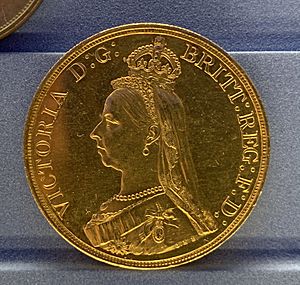
In June 1887, new designs were introduced for British gold and silver coins. These were made by Joseph Boehm and came out during Queen Victoria's Golden Jubilee (50 years as Queen). So, they became known as the Jubilee coinage. At the same time, new designs for the back of silver coins were made by Leonard Charles Wyon. These included coins from the sixpence to the half crown. A new coin, the double florin (worth four shillings), was also introduced. The crown (five-shilling piece) was made for general use for the first time in many years.
On Boehm's design, Queen Victoria wore a small crown, the Small Diamond Crown. She liked this crown because it was light. However, people criticised the coin design because the crown looked like it was about to fall off her head. Also, none of the new silver coins showed their value in words. This caused a problem with the sixpence coin. It was the same size as the gold half sovereign, which was worth much more. Dishonest people would cover the sixpence in gold to make it look like a half sovereign. Because of this, the Royal Mint quickly stopped making the new sixpence. They went back to the old design that clearly stated the coin's value.
The Royal Mint wanted to change Boehm's design as soon as possible. In 1888, Victoria was shown a sample coin with a new design. But it seems she didn't approve it at that time. In September 1889, the Chancellor of the Exchequer, George Goschen, wrote to Victoria. He suggested waiting a bit longer since people had gotten used to the Jubilee coins. Victoria replied that she "dislikes the new coinage very much" and wished they could go back to the old coins. Goschen wasn't sure if they could go back, but he promised to talk to the Mint about moving forward with a fresh design.
How the New Coins Were Made
Goschen decided to create a special group called the Committee on the Design of Coins in February 1891. Their job was to look at the 1887 coin designs and suggest improvements. They also had to decide which coins should have their values written on them. The committee was led by Sir John Lubbock, a politician. Other members included bankers and artists, like Sir Frederic Leighton, who was the head of the Royal Academy.
At their first meeting, the committee suggested that the double florin coin should no longer be made. They felt that since the five-shilling crown was still being made, two large silver coins were not needed. The government agreed, and the double florin had already stopped being made in August 1890. At their second meeting, the committee decided to invite several famous artists to create new coin designs. These artists were asked to submit two portraits of Victoria, both facing left. This was because the Mint thought about using different portraits on the florin and half crown to avoid confusion, as they were similar in size. The artists were offered £150 for their work, but two artists felt this wasn't enough and declined.
The artists had to submit their designs by October 1891. In November, the committee met to review them. They chose the designs for the front of the coins (obverse) made by the sculptor, Sir Thomas Brock. The committee decided to keep the famous 1817 Saint George and the Dragon design by Benedetto Pistrucci on the back (reverse) of the crown, sovereign, double sovereign, and five-pound coins. They also added this design to the half sovereign. For the sixpence and half crown, designs by Brock were chosen. For the shilling and florin, designs by Edward John Poynter were selected.
At a later meeting, the committee asked Brock to change his first portrait of Victoria to look more like the Ashanti medal from 1874. This helped create the "Old Head" look. Both sculptors also had to make small changes to their designs for the back of the coins. These changes were approved in March 1892. The committee first suggested using a second portrait of Victoria only on the florin. But Victoria didn't like this idea, thinking it wouldn't help people tell the coins apart. So, the committee changed their report. The new florin was made a little smaller in size.
The sculptors were told to include Victoria's name and titles on their designs in Latin. This would be "Victoria, by the Grace of God, Queen of the British Realms, Defender of the Faith." Victoria had been asking since 1888 for her title as empress of India to be on the coins. On February 12, 1892, the Prime Minister, Lord Salisbury, wrote to her. He said that her advisors believed the title "Empress of India" should be on the coins, shortened to "Ind Imp." This was because it showed her connection to most of her subjects. Even though a law said she couldn't use that title only within the UK, the government decided it was okay since the coins would also be used in the colonies.
On March 12, 1892, the designs were sent to the Queen's private secretary. The Queen generally liked the "Old Head" portrait. However, she didn't like Brock's second portrait, which was then dropped. She also disliked Brock's design for the back of the half crown and Poynter's for the shilling. The sculptors made new versions. It was unclear who would engrave the designs onto the metal dies used to make coins. The Royal Mint's engraver had died in 1891. Brock eventually suggested George William De Saulles, an engraver from Birmingham.
Victoria did not pose for Brock. The sculptor worked from her photographs. He first made a wax model, then a plaster copy. Once the committee approved his work, he made a new copy, making sure the design was flat enough for coins. De Saulles used a special machine to make coin-sized metal pieces called "hubs." These hubs were used to create the actual coin dies. De Saulles also smoothed out any small lines on the hubs under Brock's guidance. Poynter did the same for his designs. De Saulles was very important for making sure the Queen's profile and the lettering on the coins looked good.
Coin Design Details
Brock's design for the front of the coin shows an older Victoria facing left. She wears a special crown (diadem) partly covered by a veil that hangs down behind her ear. Her hair is swept up, and she has a single earring. She wears a fancy top with a royal cloak over it. On the cloak, you can see the Star of the Order of the Garter, a special award. The designer's initials, "TB," are usually found under her bust, near the "D" in "IND."
Most of the coins have the Latin phrase "VICTORIA DEI GRA BRITT REGINA FID DEF IND IMP" on the front. This means "Victoria, by the Grace of God, Queen of the Britains, Defender of the Faith, Empress of India." On the half crown, this Latin phrase is split. "VICTORIA DEI GRA BRITT REG" is on the front, and "FID DEF IND IMP" is on the back. The "IND IMP" (Empress of India) was new to British coins, but Victoria had wanted it since 1888. She finally got it with the Old Head coinage five years later. The word "Britanniarum," meaning "the Britains," was shortened to "BRITT" because of William Ewart Gladstone, a politician and Latin expert. He said that when you shorten a plural Latin word, you double the last letter.
The phrase "DECUS ET TUTAMEN" ("an ornament and a safeguard") was added to the edge of the crown coin. The year of Victoria's reign in Roman numerals was also added. For example, some 1893 crowns show "LVI" (56th year) and some "LVII" (57th year). This continued until 1900. Crowns with "DECUS ET TUTAMEN" on the edge were first made during the time of Charles II. Back then, this edge design helped stop people from illegally cutting off small pieces of metal from the coins.
The gold coins featured Pistrucci's famous Saint George and the Dragon design. The feather on Saint George's helmet, which had been changed before, was redesigned. The half sovereign also had Pistrucci's design but didn't have his initials. The numismatist (coin expert) Richard Lobel joked that Pistrucci, who liked to spell his name out, would have hated that! Australian mints in Sydney and Melbourne also made gold sovereigns with Brock's portrait from 1893 to 1901. A new mint in Perth started making similar coins from 1899 to 1901. Half sovereigns were also made in Australia, but not every year.
The half crown was the first coin of its value to show its value on its face. It showed a shield inside the collar of the Order of the Garter, a special knightly order. Poynter's designs for the shilling and florin showed separate shields with the symbols of England, Scotland, and Ireland. These were surrounded by a Garter. The shilling had its value written on it from 1831 until the Jubilee redesign. The words "ONE SHILLING" were brought back. The sixpence and threepence coins kept their old designs. Now, all coins smaller than the crown showed their value. On the penny and its smaller coins, the figure of Britannia was made to look more upright and alert. The sailing ship and lighthouse that used to be on either side of her were removed, though the lighthouse came back in 1937.
Sir John Craig, who wrote a history of the Royal Mint, thought Brock's designs were the "least unsuccessful" of those submitted. Peter Seaby, another coin historian, called the portrait "a new and improved portrait of the queen," noting it was larger than on the Jubilee coins. Leonard Forrer, in his 1916 book about medallists, called the front of the coin "a splendid portrait of the Queen." However, he felt Poynter's designs for the back were "not very satisfactory."
How the Coins Were Used
On January 30, 1893, the day the new coins were officially announced, the Royal Mint showed them to the press. The reaction was much more positive than it had been for the Jubilee coins six years earlier. The Birmingham Daily Post newspaper said that "the result is a distinct success... Her Majesty's features have a most pleasing expression." The Pall Mall Gazette said the new coins were much better than the Jubilee ones. They also noted that even though the "Empress of India" title was added late, it was definitely valid because British coins were used in the colonies.
The Lancaster Gazetter wrote on February 8, "The new coinage starts at a great advantage, for it replaces some of the most unfortunate designs that the Mint has ever put in circulation. In a few days' time it will be in everybody's hands." The Daily News wrote:
The new coinage is a huge improvement. A Greek artist would have approved of Mr. Brock's design of the Queen's head. Instead of that silly little crown from the Jubilee time, Mr. Brock puts a simple, beautiful tiara. A veil hangs gracefully from the back of it down to her shoulders. Finally, there's something you can look at without laughing. The portrait is excellent. As for the tiara, it's the ornament her Majesty usually wears on important occasions.
Not everyone liked the Queen's new look on the coins. A politician named James Parker Smith said in Parliament that the new sovereigns reminded him of cheap game tokens. He felt that anyone who knew about coins wouldn't be happy with them. Queen Victoria herself might not have been completely satisfied. The new chancellor, William Harcourt, wrote to her in February 1893, agreeing that "the Queen's head in the new coinage leaves much to be desired both in likeness and execution." The painter Philip Wilson Steer felt that the Queen's necklace, earring, and medals made the new coin look "a certain tawdry look." He also thought Poynter's designs were too crowded. Some people from Wales complained that there were no Welsh symbols on the coins, even though England, Scotland, and Ireland had theirs.
Despite some criticisms, the new coins were generally well-received. The Royal Mint's Deputy Master, Fremantle, called the new portrait "almost the popular portrait of the Queen." He also praised De Saulles for his role in the coins being liked by both experts and the public. Special sets of "proof" coins (very high-quality coins made for collectors) from 1893 were sold by the Royal Mint.
No bronze coins (like the penny) had been made with the Jubilee portrait because there were already many of them. In 1895, De Saulles changed Brock's portrait for the bronze coins and made some changes to their backs. These new bronze coins were officially released on May 11, 1895.
The Australian mints in Melbourne and Sydney made sovereigns every year from 1893 to 1901. Half sovereigns were made in Sydney every year, and in Melbourne in 1893, 1896, 1899, and 1900. In 1899, a third Australian mint, the Perth Mint, started making sovereigns. It made sovereigns in 1899, 1900, and 1901, and half sovereigns in 1899 and 1900.
Queen Victoria passed away in January 1901. Coins showing her, dated 1901 and using Brock's portrait, continued to be made. This continued until the new coins for her successor, Edward VII, were ready in May 1902.


